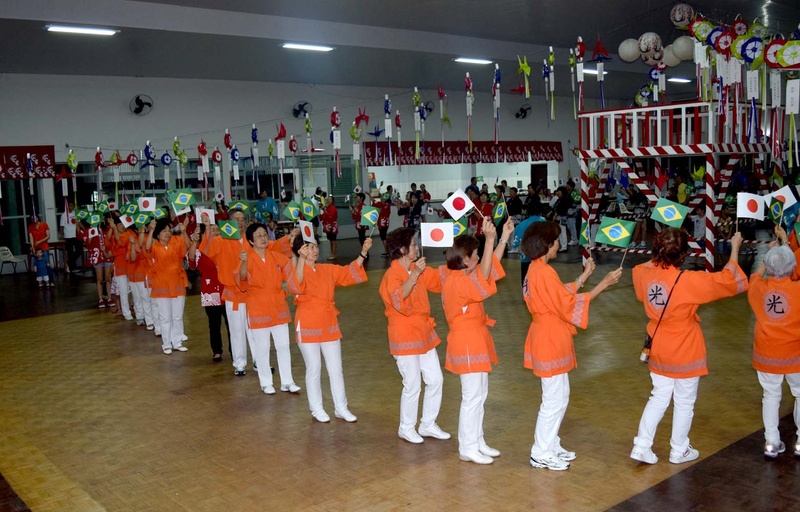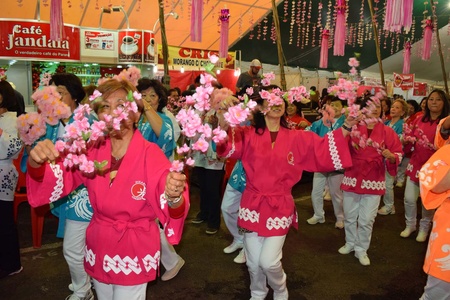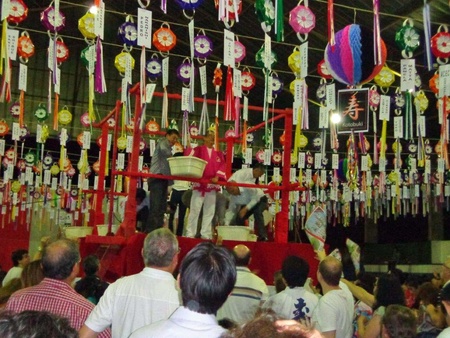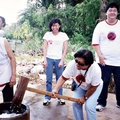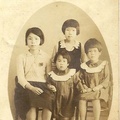We belong to a generation of children, youths, adults, and seniors who are descendants of Japanese immigrants who came to Brazil in the years before World War II. Some are children, others are grandchildren, great-grandchildren, and great-great-grandchildren of these immigrants.
After leaving Japan, our ancestors gradually began to absorb Western culture, although the influence of Japanese culture has been preserved in many families, especially when the younger generations come in contact with older people who pass on to the younger ones the values, the customs, the cuisine, and the Japanese language.
In Brazil, the largest Japanese colony is found in the state of São Paulo. The second largest is located in the northern region of the state of Paraná, chiefly in the city of Londrina.
The Nikkei influence can be clearly felt in this city through festivals that attract large crowds who appreciate the music, dancing, cooking, crafts, and religion, thus enabling the integration of Eastern and Western cultures.
The Hikari Group of Londrina was created in 2005 with the aim of promoting Japanese culture, while focusing on the Bon Odori, charity events, and group meetings to strengthen the friendship, teamwork, and overall quality of life among its members.
The name Hikari – meaning light or brightness in Japanese – was chosen by the initial members at the time the group was formed.
There are approximately 80 members who get together to dance, take part in gatherings, such as shinenkai at the beginning of the year; tandyokai, to celebrate the birthdays that take place in each quarter; and bonenkai at the end of the year, in addition to participating in the organization of events such as the Mochitsuki – the Mochi Festival, and the Odori Fest – the Bon Odori Festival.
At social gatherings the menu is offered in the motiyori manner in which each participant brings a plate of sweets or snacks to share with the others. Some people wrap their dishes with furoshiki, a type of square dishcloth tied at the ends so as to keep the contents in place. The food is varied, including, of course, nishimê, a vegetable stew that is served after everyone has made the toast with the words banzai, viva!
The Mochitsuki – Mochi Festival is an event the group has been organizing since 2006; its purpose is the preservation of the immigrants’ tradition in the preparation and savoring of cupcakes made with motigome– a special type of rice – and to raise funds to help institutions in need, such as the wajunkai, a nursing home for the elderly located in the city of Maringá, Paraná.
Mochi, known as the prosperity cake, is traditionally eaten at the shogatsu family gatherings during the New Year celebrations, and, in daily life, in recipes such as ozoni – a broth with seaweed, vegetables, and meat – and zenzai – a sweet broth made with a special kind of bean, azuki.
Another way to enjoy mochi is to first heat it and then moisten it in a shoyu mix that consists of soy sauce and a little sugar. Some people in the group enjoy eating mochi with nattô – a fermented soy-based dressing.
The highlight of the Odori Fest, traditionally held in November in the city, attracts delegations from a number of cities in the region to come dance bon odori, the traditional Japanese dance that entices the older ones with the tanko bushi, sakura ondo, shinran ondo, naniwa bushi dayo jinseiya choreographies, to name a few, while the younger ones eagerly look forward to the beats of the taiko, or Japanese drums, announcing the start of the matsuri dance, which is a more modern version of the bon odori.
People dance in a circle around the yagura, a sort of platform where the players play their drums.
During the dance presentations, we generally wear the happi, a garment with a group identification logo, or the yukata, which is similar to the kimono, but more traditional, besides being easier to wear and suitable for the summer.
The festivities area is decorated with approximately 1,000 tyotins or origamis, which are folded-paper artwork featuring the names of those who acquired them, in addition to ornaments representing the sakura which, according to tradition, has the power to attract good vibes and harmonize the environment.
The most anticipated moment of the festivity is the ame mochi – rice-cupcake rain – when 10,000 mini-mochis, or individually packed rice cupcakes, are handed out to those in attendance as a symbol of peace, joy, and happiness to all.
In the tents outsourced by the organization you’ll find dishes such as yakisoba, with ingredients that include meat, noodles, and vegetables; sukiyaki, with ingredients similar to those found in yakisoba, but prepared with a different sauce, udon, which is a noodle-based broth served in the tyawan and accompanied by the hashi, wooden chopsticks replacing the silverware; sushi, or rice dumplings topped with some sort of of algae and other Asian delicacies; in addition to Western dishes such as pastéis [in the U.S. known as “Brazilian empanadas”] and churrasquinhos [meats on sticks].
When we travel on vacationor attend festivals in other cities, whether in Paraná or other states, we usually bring bento with us; that’s a sort of packed lunch containing not only sushi, but also yakisakana, or grilled fish; tsukemono, which are pickle-like preserves; an omelet; and other tasty snacks that we can eat during the trip or in the spots where people usually take a break from the road whenever they travel by bus or by car.
The bon odori festivals have been held at public spaces such as city squares and convention centers; otherwise, they take place in the kaikan, associations where the local Nikkei community gathers. Traditionally, visitors are served typical Japanese dishes prepared by members of the fujinkai, or ladies' association.
We usually deliver an orei, an envelope containing a certain amount of money, to the event coordinators in order to help with the expenses, including the meal offered to us.
The Hikari brings together people who are at peace with life, but there are sad occasions as well, such as the death of friends, family members, and other group participants, when we provide support to one another while attending a wake or a funeral.
Depending on the family bond or the closeness of the friendship, we give a kooden – an envelope with money – to family members; or, in accordance with the Western custom, we send a wreath. In most instances, the religious ceremony is performed by the bonsan, a Buddhist monk; or, by representatives of other Eastern or Western religions.
The word mottainai has a special meaning to the group: don’t waste food, don’t leave tap water running, save on the amount of detergent you use, and so on. The mottainai philosophy can help us to understand how we relate to the environment, thus avoiding waste.
It is interesting to note that the group members, as they were born in Brazil, many of them having a university degree, are perfectly fluent in Portuguese, but in their day-to-day lives they usually communicate by mixing the two languages.
Common expressions include: hang on, guys – ganbatte ne; there’s no way out of this – shoganai ne; I'm tired – tsukareta ne; I’m sorry – sumimasen; how are you? – genki deska; I’m going to serve myself [or “let’s eat”] – itadakimasu.
The following are common expressions in the daily lives of immigrants and their descendants in Brazil: please, put this in the fridge – geladeira [refrigerator] naka ni oitekudasai;let’s cover the table with the tablecloth – let’s cover the table kake; I left it in the bag – bolsa [bag] ni okimashita; I’m going to take the bus home – ônibus [bus] de kaerimasu; come to lunch – ni kitekudasai almoço [lunch].
The Hikari Group conducts presentations at high schools and universities, businesses and other institutions, with the goal of becoming integrated with the non-Nikkei community, and thus contributing to the dissemination of Japanese culture.
This exchange allows the group to share with them values such as punctuality, commitment, solidarity, order, and the cleaning up of the environment, besides awakening in them an interest in the Japanese language, arts, cuisine, and sports.
We are Nikkei born in Brazil; we are proud to be Brazilian, but our roots lie on the other side of the world, in the land of the rising sun!
© 2016 Alba Shioco Hino, Nilza Matiko Iwakura Okano, Kiyomi Nakanishi Yamada




